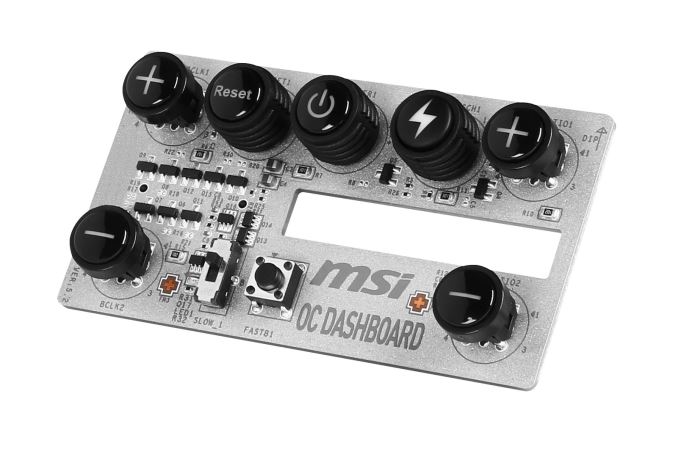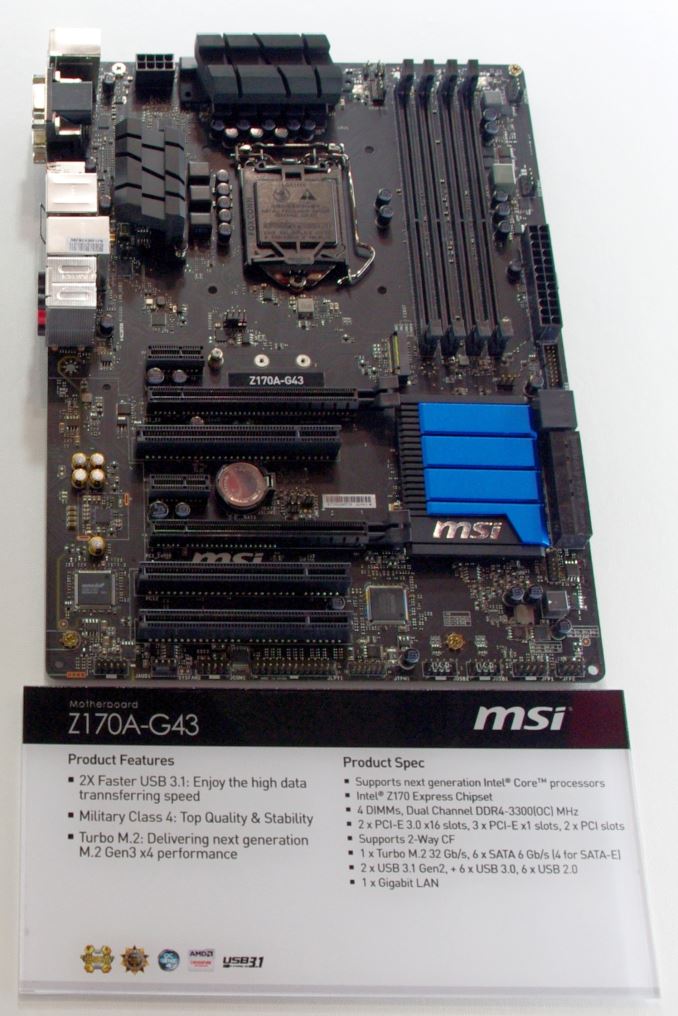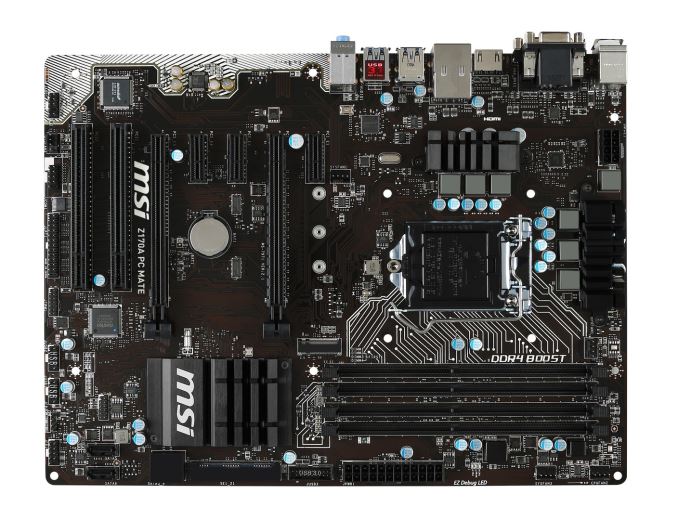Intel Skylake Z170 Motherboards: A Quick Look at 55+ New Products
by Ian Cutress on August 5, 2015 7:59 AM ESTMSI Z170: Other Gaming Boards and Channel
MSI Z170A XPower Gaming Titanium Edition
Everyone remembers when MSI’s overclocking range of motherboards were yellow, right? Well how about if they turned a silvery gleam? Welcome to Skylake, because MSI has you covered.
The XPower Gaming Titanium Edition (XPGT for short) is one of those products trying to break new areas of aesthetics. Some will like it, some will not – as far as we can tell, the design itself has little effect on actual levels of performance, but this is an XPower part of the line-up, meaning it is MSI’s more overclocking (and extreme overclocking) focused model. As a result, and to go with the name, the power delivery uses many Titanium chokes, we get a potential 4-way CrossFire using CPU and PCH lanes, and the OC panel has changed a fair bit.
The OC Dashboard is designed to attach to the motherboard in the top right and give the OC buttons needed, such as power/reset, base frequency/multiplier adjustments, a full system reset, fast boot and a slow mode switch. For users that don’t need it, it should be able to be left off.
Along with the matching steel armor on the PCIe slots we get two M.2 slots which according to my schematics can both be used in PCIe 3.0 x4 mode at the same time, although each one will lose you two SATA ports. It seems slightly odd that these are all made dependent when Z170 has enough chipset lanes to go around, but this is what MSI has done.
USB 3.1 on the rear panel comes in the form of two Type-A ports from the ASMedia ASM1142 controller, while networking duties are form the Intel I219-V and audio is an enhanced Realtek ALC1150 solution.
Pricing for the XPGT is set for £240, or $310 in the US.
MSI Z170A Krait Gaming
The Krait line from MSI initially started as just a simple white on black theme, but then somehow developed a following, a snake head logo and now gets merged into MSI’s Gaming line like everything else. Typically the Krait name is reserved for a cheaper ATX motherboard that supports SLI, and here we have that without USB 3.1 and only two video outputs. There is an M.2 slot that runs in PCIe 3.0 x4 mode, as well as an Intel I219-V network controller and a Realtek ALC1150 audio codec.
Pricing for the Z170 Krait Gaming should come in at £125/$162.
MSI Z170A-G45 Gaming – image from TechPowerUp
The Z170A-G45 Gaming is actually a minor variant on the Gaming M5 with a slightly different arrangement for the voltage read points and a single USB 3.1-C rather than two USB 3.1-A ports. The G45 version also seems to have a VGA on the rear panel, but apart from that it looks pretty much the same from a design standpoint.
The M5 was set around $195, so I’d imagine this to be similar.
MSI Z170A-G43
We saw the Z170A-G43 at Computex, which (like the G45 seems) to be a slight variant from the Gaming M line. This time the G43 seems to align with the M3 with a slightly different SATA arrangement, a different aesthetic, and I’d imagine given the design it should be using either the Intel I219-V or the Realtek network ports. Similar to the previous board, the G45 also seems to be equipped with a VGA port but similar to the M3, this board does not seem to support SLI giving a single PCIe 3.0 x16 from the CPU and then a PCIe 3.0 x4 from the chipset.
MSI Z170A PC Mate
MSI’s PC Mate line is a little bit of an oddball here, not being given the Gaming name. That is because it sits more in that internet café style of system or bulk office ATX design. This means separate PS/2 connectors on the rear panel, the three most common VGA outputs, a single M.2 x4 slot, two USB 3.1-A ports on the rear (the ones on the right), a basic audio codec (looks like ALC892) and a Realtek network controller. The PC Mate motherboard, despite being in the Z170 level of motherboards, is more designed to make a non-overclocking CPU happy with a set of basic functionality to satisfy users who don’t actually own the PC they are working on.




































85 Comments
View All Comments
utmode - Wednesday, August 5, 2015 - link
Why so many sata express in so many motherboard?Dahak - Wednesday, August 5, 2015 - link
Yeah, I dont get that either, it does not seem like anyone is doing sata express drives, when NVMe is about to come out. Although its only wasting board space as the SateExpress port can double as 2xSATA ports. I was kinda hoping they would have dropped it for this. Maybe on the other chipsets?Kristian Vättö - Wednesday, August 5, 2015 - link
I think the reason lies in the marketing departments wanting to tick a box in the marketing materials. When one manufacturer includes it, everyone follows the suit so their products won't look "inferior" compared to competitors'. It's no secret that SATA Express is practically dead (although I would say it's a miscarriage), but to those with less technical knowledge it may sound cool and better than regular SATA, even though they will end up using SATAe as regular SATA.Ian Cutress - Wednesday, August 5, 2015 - link
ASRock have their USB 3.1 front panel which uses SATA Express, so there's finally some use for it.silenceisgolden - Wednesday, August 5, 2015 - link
It would work better for marketing departments if they market that they "did not bother with the useless standard, SATA Express".DanNeely - Wednesday, August 5, 2015 - link
The design cycle for these boards probably started a good year ago. By the time it became clear that Sata-Express was a dead standard it was too late to make any major design changes for the initial wave of boards.Slash3 - Sunday, August 9, 2015 - link
As someone with 10 SATA devices, I very much appreciate I/O overkill. :)phorgan1 - Monday, December 21, 2015 - link
You can get more sata in less lanes. Once you use up lanes for nvme drives and graphics cards, the smaller groupings won't support more cards or nvme drives (cards need x8 or x16 and nvme drives need x4) the left overs will support usb and sata. Since sata is such lower bandwidth you can still fit a lot of sata in around the fringes, so why not? A sata ssd is still pretty fast.prophet001 - Wednesday, August 5, 2015 - link
Why no slot for M.2 drives?prophet001 - Wednesday, August 5, 2015 - link
Nevermind. Hadn't fully read the article.